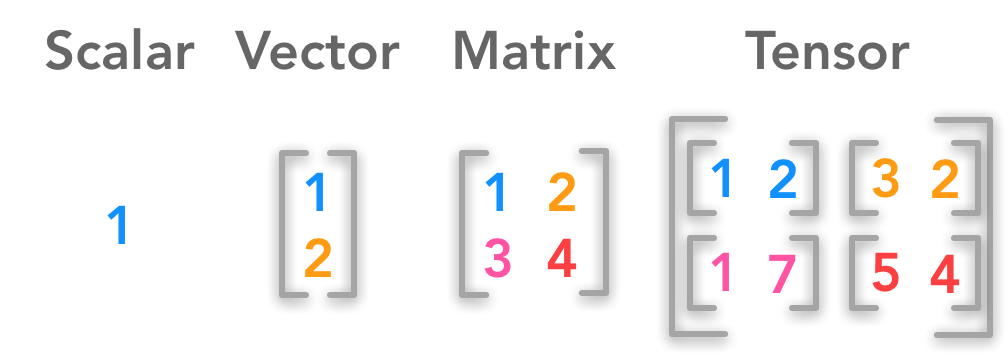Learning about Tensors¶
Day 2¶
It turns out Tensors are legos of AI world. As everything that we do is converted into numbers and lists, Tensors are responsible for managing those. Now this is where it's time to take first Maths lesson.
Math lesson - What are Tensors ?¶

Tensors are ways to store data in multi-dimensions. , very good representation of it is at here
Checkout few videos about Tensors here -
English
Hindi
import torch
/Users/krishnaglodha/anaconda3/envs/aidoc/lib/python3.10/site-packages/torch/nn/modules/transformer.py:20: UserWarning: Failed to initialize NumPy: No module named 'numpy' (Triggered internally at /Users/runner/work/pytorch/pytorch/pytorch/torch/csrc/utils/tensor_numpy.cpp:84.)
device: torch.device = torch.device(torch._C._get_default_device()), # torch.device('cpu'),
Simplest representation of tensors is single number¶
scalar = torch.tensor(7)
scalar
tensor(7)
# see dimensions
print(f"dimension of scalar is {scalar.ndim}")
# see shape
print(f"shape of scalar is {scalar.shape}")
# see item
print(f"item in scalar is {scalar.item()}")
dimension of scalar is 0 shape of scalar is torch.Size([]) item in scalar is 7
Representation of list as tensors¶
vector = torch.tensor([1,2,4,5])
vector
tensor([1, 2, 4, 5])
# see dimensions - how many lists are there in the tensor
print(f"dimension of vector is {vector.ndim}")
# see shape - shape represents how many elements are there in the tensor list
print(f"shape of vector is {vector.shape}")
# see item - Item can be only scalar, thus we went at 0th index of vector and got that item
print(f"item in vector is {vector[0].item()}")
dimension of vector is 1 shape of vector is torch.Size([4]) item in vector is 1
Representation of matrices as tensors¶
As you can see in case of matrix we have a Bigger list, which contains 2 smaller lists, and each of this small list contains equal number of items.
MATRIX = torch.tensor([[1,2,4,5],[3,4,2,9],[3,1,8,64]])
MATRIX
tensor([[ 1, 2, 4, 5],
[ 3, 4, 2, 9],
[ 3, 1, 8, 64]])
# see dimensions - how many lists are there in the tensor )
print(f"dimension of MATRIX is {MATRIX.ndim}")
# see shape - shape represents how many elements are there in the tensor list ( here we have 3 lists and each list has 4 elements)
print(f"shape of MATRIX is {MATRIX.shape}")
# see item - Item can be only scalar, thus we went at 0th index of MATRIX , we got list there [1,2,4,5], thus we went inside that list and looked for 0th element and got that item
print(f"item in MATRIX is {MATRIX[0][0].item()}")
dimension of MATRIX is 2 shape of MATRIX is torch.Size([3, 4]) item in MATRIX is 1
Representation of multi-dimension matrices as tensors¶
Complex data can be a combination of multiple matrices, which are known as tensors
As shown below , Tensor is a bigger list, which has 2 big lists , and each of there big lists have 3 smaller lists, and each of this smaller list has 2 values in them.
# TENSOR
TENSOR = torch.tensor([[[1,4],[3,1],[5,4]],
[[11,14],[33,13],[56,64]]])
# see dimensions - how many lists are there in the tensor )
print(f"dimension of TENSOR is {TENSOR.ndim}")
# see shape - shape represents how many elements are there in the tensor list ( here we have 3 lists and each list has 4 elements)
print(f"shape of TENSOR is {TENSOR.shape}")
# see item - Item can be only scalar, thus we went at 0th index of TENSOR , we got 2 lists each, thus we went inside that list and found 3 more lists, then we went inside that list and looked for 0th element and got that item
print(f"item in TENSOR is {TENSOR[0][0][0].item()}")
dimension of TENSOR is 3 shape of TENSOR is torch.Size([2, 3, 2]) item in TENSOR is 1
Create tensor based on random numbers¶
In nueral network the way things works is we start by assigning random numbers in tensor and then based on input data, these numbers are corrected.
The flow looks like
Create random tensor ➡️ check it with data ➡️ correct it based on data ➡️ check it with data ➡️ correct it based on data
# Create random TENSOR
random_TENSOR = torch.rand(2, 3) # give size of tensor
random_TENSOR
tensor([[0.6117, 0.8783, 0.0312],
[0.8228, 0.2097, 0.6913]])
# Create random TENSOR
another_random_TENSOR = torch.rand(3,2, 3) # give size of tensor
another_random_TENSOR
tensor([[[0.0935, 0.5212, 0.1298],
[0.9620, 0.9641, 0.4545]],
[[0.1546, 0.8876, 0.1105],
[0.9638, 0.4953, 0.2858]],
[[0.6359, 0.5181, 0.8909],
[0.8295, 0.2972, 0.3061]]])
# Get all values as zero in tensors
all_zeros = torch.zeros(3, 3)
all_zeros
tensor([[0., 0., 0.],
[0., 0., 0.],
[0., 0., 0.]])
# Get all values as one in tensors
all_ones = torch.ones(3, 3)
all_ones
tensor([[1., 1., 1.],
[1., 1., 1.],
[1., 1., 1.]])
# Get all values in a range in tensors
all_ranges = torch.range(start=23, end=45, step=3)
all_ranges
/var/folders/b5/2422fkd93kq4kkfc_d1vpym00000gn/T/ipykernel_94871/818810665.py:3: UserWarning: torch.range is deprecated and will be removed in a future release because its behavior is inconsistent with Python's range builtin. Instead, use torch.arange, which produces values in [start, end). all_ranges = torch.range(start=23, end=45, step=3)
tensor([23., 26., 29., 32., 35., 38., 41., 44.])
# convert all elements in tensor to zero
ranges_converted_to_zero = torch.zeros_like(all_ranges)
ranges_converted_to_zero
tensor([0., 0., 0., 0., 0., 0., 0., 0.])
# convert all elements in tensor to one
ranges_converted_to_one = torch.ones_like(all_ranges)
ranges_converted_to_one
tensor([1., 1., 1., 1., 1., 1., 1., 1.])